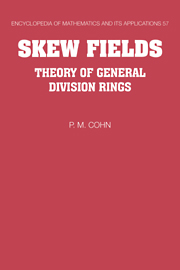Book contents
- Frontmatter
- Contents
- Preface
- Note to the reader
- Prologue
- 1 Rings and their fields of fractions
- 2 Skew polynomial rings and power series rings
- 3 Finite skew field extensions and applications
- 4 Localization
- 5 Coproducts of fields
- 6 General skew fields
- 7 Rational relations and rational identities
- 8 Equations and singularities
- 9 Valuations and orderings on skew fields
- Standard notations
- List of special notations used throughout the text
- Bibliography and author index
- Subject index
Prologue
Published online by Cambridge University Press: 05 November 2011
- Frontmatter
- Contents
- Preface
- Note to the reader
- Prologue
- 1 Rings and their fields of fractions
- 2 Skew polynomial rings and power series rings
- 3 Finite skew field extensions and applications
- 4 Localization
- 5 Coproducts of fields
- 6 General skew fields
- 7 Rational relations and rational identities
- 8 Equations and singularities
- 9 Valuations and orderings on skew fields
- Standard notations
- List of special notations used throughout the text
- Bibliography and author index
- Subject index
Summary
O glücklich, wer noch hoffen kann,
Aus diesem Meer des Irrtums aufzutauchen!
Was man nicht weiss, das eben brauchte man,
Und was man weiss, kann man nicht brauchen.
Goethe, Faust IOne of the principal aims of this book is to describe some methods of constructing skew fields. The case most studied so far is that of skew fields finite-dimensional over their centres. But a finite-dimensional k-algebra, where k is a commutative field, is a field whenever it has no zero-divisors. On the one hand this enormously simplifies their study, while on the other hand it puts many constructions out of bounds (because they produce infinite-dimensional algebras). The study of fields that are not necessarily finite-dimensional over their centres is still in its early stages, and the methods needed here are not very closely related to those used on finite-dimensional algebras – the relation between these subjects is rather like the relation between finite and infinite groups.
There are some ways of obtaining a field directly, for example Schur's lemma tells us that the endomorphism ring of a simple module is a field, and the coordinatization theorem shows that when we coordinatize a Desarguesian plane, the coordinates lie in a field. But these methods are not very explicit, and we shall have no more to say about them. For us the usual way to construct a field is to take a suitable ring and embed it in a field.
- Type
- Chapter
- Information
- Skew FieldsTheory of General Division Rings, pp. 1 - 2Publisher: Cambridge University PressPrint publication year: 1995

